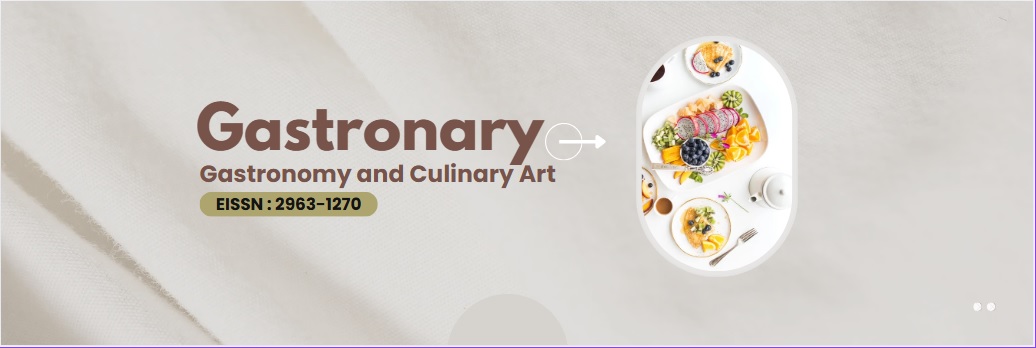Kroket Past and Present Culinary Modifications and Innovations of The People of Palu City
DOI:
https://doi.org/10.36276/gtr.v1i1.380Keywords:
Croquettes, Culinary, food Modification, food Innovation, GastronaryAbstract
Culinary has mushroomed in almost every area, including Palu City, which is dubbed the City by the local community, having snacks using sweet potatoes as the main ingredient for making croquettes with vegetable ragout filling from carrots, sweet potatoes and sprouts, which are Palu croquettes. Kroket has various names that differ in each country, as France is called (croquet)crispy, while the Netherlands is called Kroketten. Bitterballen is made from meat ragout, cheese mixed with sauce and seafood. One of the famous croquette restaurants in Amsterdam Is Van Dobben and hotlkmp Pattiserie, both o which are renowned for Dutch croquettes. From its history, croquettes can now be found in almost all of Indonesia, one of which is the city of Palu. After the croquette is implemented in hot oil, it is like a rocket that can fly from the bottom to the top by looking at the foam on the fried croquettes because the croquettes have been sprinkled with egg white producing the froth of the croquettes themselves. The modification of the main ingredient of potato is changed to sweet potato so that the lower class people can consume croquettes instead of using potato as the primary ingredient, which is a little more expensive than a sweet potato. From here, culinary lovers modify and innovate to change the main ingredients to still make croquettes with a taste and texture that is soft, sweet, savoury, crunchy and coated with a sprinkling of bread and then fried golden. This one dish can be found every day at the Kori shop located on Jalan Attorney General Huntap 1 Tondo, making this one of the most popular snacks the people of Palu City enjoy.
References
Ali, A. (2013). Kualitas Umbi beberapa Klon kentang (salonum tuberosuml) dataran medium untuk keripik. Bandung : Berita Biologi 12 (1)-April.
Amalia, P dkk. (2021). Teknologi Inovatif pengelolahan makanan untuk peningkatan kapasitas produksi UMKM di Kabupaten Sidoharjo. Kacanegara Jurnal Pengabdian pada Masyarakat.
Budi, S. (2011). Kentang dan Analisis Usaha Tani. Yogyakarta : Kanisius
Elly, S. (2021). Ketika makanan adalah seni, skill, sejarah dan budaya. www.kompasiana.com diakses kamis, 18 Agustus 2022 pukul 22.00wita.
Fadly, R. (2016). Jejak rasa Nusantara: Sejarah makanan indonesia. Jakarta . Gramedia Pustaka Utama
Fadly, R. (2020). Kita Belajar Sejarah dari Makanan. Bandung: Kantor Komunikasi Publik.
Haliadi. (2008). Nosarara Nosabatutu (bersaudara dan bersatu). Palu : P_Idea dan Pussej Untad.
I Nyoman Dharma Putra. (2017). Simbiosis Mutualistis Pariwisata dan Warisan Budaya Kuliner di Gianyar. Bali : Pustaka Budaya
Komang, T. (2022). Pariwisata Nusantara : Keberagamaan Indonesia dalam Cita rasa Kuliner Nusantara. Bandung : CV Media Sains Indonesia.
Kompas.com. (2021). Sejarah Kroket, cemilan gurih yang Populer. https://www.kompas.com. Akses 7 Agustus 2022 pukul 06.51 wita
Kuntowijoyo. (2003). Metodologi Sejarah. Yogyakarta :Ombak
Luh Putu Wrasiati dkk. (2017). Kuliner Tradisional Bali: Jajajan Tradisional, Masakan Tradisional, dan Sayuran Tradisional. Bali : Udayana University Press.
Mestika, Z. (2008). Metode Penelitian Kepustakaan. Jakarta : Yayasan Obor Indonesia.
Putu Diah Sastri Pitanatri. (2016). Inovasi dalam kompetisi : Usaha Kuliner Lokal menciptakan keunggulan kompetitif di Ubud. Jumpa, 3 nomor 1 Juli.
Rizka, F. (2020). Kue klasik ngetren 5 fakta kroket yang tercipta karena kasus kelaparan. Jakarta : Detikfood
Rosidah. (2014). Potensi Ubi Jalar sebagai Bahan baku Industri pangan. Jurnal Teknobuga, 1(1)
Sartono Kartodirdjo (2013). Sejarah Sosial: konseptualisasi, Model dan tantangannya. Yogyakarta : Ombak
Woodward (ed). (1999). Kuliner sebagai identitas budaya : Persepktif komunikasi lintas budaya. Metadata ISSN 2087-3352.
Downloads
Published
How to Cite
Issue
Section
License
Copyright (c) 2022 Komang Triawati

This work is licensed under a Creative Commons Attribution-ShareAlike 4.0 International License.






